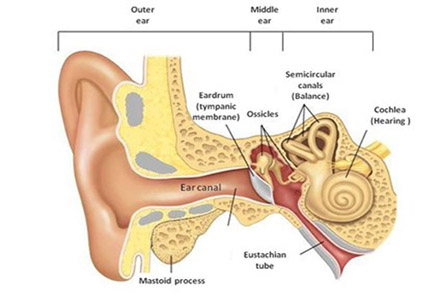Mastoidectomy
Introduction
A mastoidectomy is a surgical procedure to remove an infected portion of the mastoid bone situated behind the ear when conservative medical treatment has failed.
The purpose of mastoidectomy:
The purpose of this surgery is to remove the infected air cells known as mastoid air cells. These cells are infected by spread of infections from ear, such as chronic otitis or by inflammatory disease of the middle ear known as cholesteatoma. The mastoid air cells are open spaces which contain air and are located throughout the mastoid bone. This is the prominent bone located behind the ear that extends from the temporal bone of the skull. The air cells coalesce into a common cavity in the upper part of the bone, which is in turn opens into the middle ear. Thus, infections in the middle ear can sometimes spread in the mastoid bone. When antibiotics fail in curing the infection, it becomes necessary to remove the infected area by surgery. Mastoidectomy is also performed to repair paralysis of facial nerve.
We have all the information you need about public and private clinics and hospitals that provide ENT surgeries in Iran, Islamic Republic Of with the best quality and lowest possible prices

Description:
This surgery is done under general anesthesia. There are several different types of mastoidectomy procedures, which depend upon the amount of infection present:
• Simple (or closed) mastoidectomy- This surgery can be performed through the ear or through an incision behind the ear. Then, the surgeon opens the mastoid bone and removes the infected air cells. Middle ear is drained by an incision on the eardrum. After this, topical antibiotics are placed in the ear.
• Radical mastoidectomy. This procedure is done in case of extensive spread of a cholesteatoma. The eardrum and middle ear structures are completely removed. Only the ear ossicle known as the stapes or the “stirrup” shaped bone is not removed to preserve some hearing.
• Modified radical mastoidectomy- In this procedure, some middle ear bones are not removed and the eardrum is reconstructed by a procedure called tympanoplasty.
After completion of surgery, the wound is sutured around a drainage tube and a dressing is applied.
The cholesteatoma
A clean, uninfected and healthy ear is the result of mastoidectomy.
Cholesteatoma is a pocket of skin-like tissue developing on the eardrum. It spreads and destroys the middle ear and subsequently spreads to the mastoid. This causes recurrent ear discharge. The cholesteatomacan also invade the ear ossicles which are three in number and are involved in hearing. This causes hearing loss. Nerve supplying the muscles of face, blood vessels as well as brain structures lie in the vicinity of the middle ear. Therefore, it is important to remove the cholesteatoma to prevent these structures from being eroded by it. This is the goal of mastoidectomy surgery.
Diagnosis
The diagnosis of cholesteatoma and middle ear infection is done by surgeon through careful examination of ear, nose, and throat. Also, diagnostic tests like an audiogram and imaging studies of the mastoid bone using X-rays or CT scans are used to evaluate the patient before the surgery.
Aftercare:
The drainage tubes inserted during the surgery are removed after a day or two of surgery. Pain-relievers are required for first two days. Stitches are removed after 3 to 5 days and large mastoid dressing is replaced by small dressing. A course of antibiotics and topical ear drops are prescribed for several days.
The patient should inform the doctor in case of following:
1. Fresh blood in dressing
2. Vomiting, stiffness of neck or disorientation
3. Facial paralysis or drooping of mouth
Risks
Complications do not usually occur, but they may include:
1. Infections such as meningitis or brain abscesses
2. Severe hearing loss
3. Temporary dizziness or vertigo
4. Temporary loss of taste on the side of the tongue
5. Facial nerve injury which is rare.
Results
A clean, uninfected and healthy ear is the result of mastoidectomy. However, both modified radical and radical mastoidectomy surgeries commonly result in some degree of hearing loss. A hearing aid usually needs to be considered after the surgery.